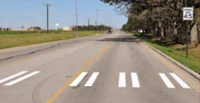MUTCD - Clarifications of Existing Standards and Guidance on New and Innovative Control Devices
by Airton Kohls (Source: FHWA HOTO-1 and HRT-10-06)
On January 5, 2017, FHWA issued a memorandum to clarify the status of several types of traffic control devices currently allowed for use by the 2009 Manual on Uniform Traffic Control Devices for Streets and Highways (MUTCD) under various types of approval, and to provide an update on the evaluation of several other types of traffic control devices under consideration for Interim Approval.
The following are traffic control devices permitted without additional approval from FHWA:
Bicycle Lane Markings Through Intersections:
Extensions of bicycle lanes are compliant with the MUTCD and can be marked as would be an extension of any other lane. The provisions of Section 3B.08 - Extensions Through Intersections or Interchanges - apply to bicycle lanes. Among other guidance, Section 3B.08 states that "Where highway design or reduced visibility conditions make it desirable to provide control or to guide vehicles through an … intersection or interchange dotted line extension markings consisting of 2-foot line segments and 2- to 6-foot gaps should be used to extend longitudinal line markings through an intersection or interchange area." It should be noted that chevron markings are not permitted to be used in bicycle lanes or bicycle lane extensions, nor are shared lane markings. Bicycle lane extensions through intersections can include standard bicycle lane arrows, bicycle symbols, or pavement word markings. Additionally, green-colored pavement can be used to enhance conspicuity if the installing jurisdiction has received approval under Interim Approval 14 (see below).
High Visibility Crosswalk Markings:
Since the publication of the 2009 MUTCD, a study on crosswalk markings was completed on behalf of the FHWA. This study, Crosswalk Marking Field Visibility Study (FHWA Publication FHWA-HRT-10-068), produced several recommendations for revisions to the MUTCD. These recommendations were to add bar pairs as a "usable crosswalk pattern", to provide typical dimensions for marking patterns, and to consider making bar pairs or continental markings the default marking for all crosswalks across uncontrolled approaches with some exceptions. It is important to note that bar pairs are compliant with the 2009 MUTCD and can be used by any jurisdiction choosing to do so. Many jurisdictions already use the bar pair crosswalk marking. It is likewise also compliant with the MUTCD if a roadway agency should choose to accept the recommendation that bar pairs or continental markings be the default crosswalk marking across uncontrolled approaches. While providing typical dimensions for crosswalk markings is under consideration for the next edition of Standard Highway Signs, many State and local roadway agencies include these specifications in their roadway design guides.
Edge Line Markings at Highway-Rail and Light Rail Transit Grade Crossings:
Edge Line Markings extending through the track area at rail grade crossings are permitted under the 2009 MUTCD. In March 2016, the FHWA issued Official Ruling 8(09)-21 (I), which clarified that the extension of tubular markers was permitted across the track area, but the requester at that time did not inquire about edge lines in similar situations. Edge lines are permitted to be extended through the track area under the 2009 MUTCD without any additional approvals.
The memorandum also includes information on traffic control devices permitted under experimental approval (Green-Backed Shared-Lane Markings and Use of Bicycle Symbol on Signs) and on requests for interim approvals (Revision to Interim Approval 16 to Allow Conflicting Movements, Two-Stage Turn Boxes and Use of Red-Colored Pavement in Transit Lanes). The memorandum can be found at: http://mutcd.fhwa.dot.gov/resources/policy/tcdstatusmemo/index.htm


The data collection and experimentation processes are critical to the progress of the MUTCD as it keeps pace with the state of the transportation engineering practice. It is critical that transportation agencies collaborate and share data and research on new and innovative traffic control devices and operations. FHWA division office in TN welcomes the opportunity to work with transportation agencies and is ready to provide assistance, direction, and guidance to any agency wishing to experiment or to utilize any of the traffic control devices discussed herein.
Back-Contents-Forward